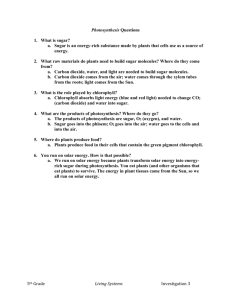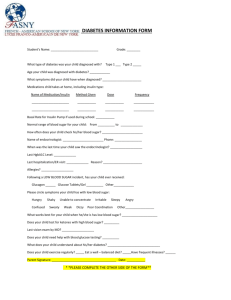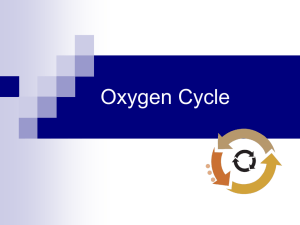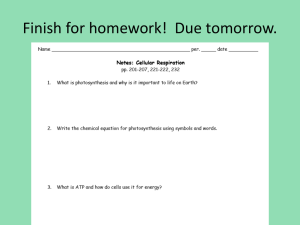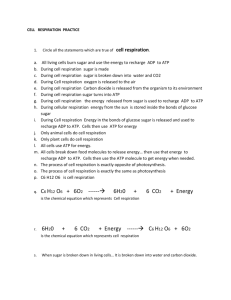handout
advertisement
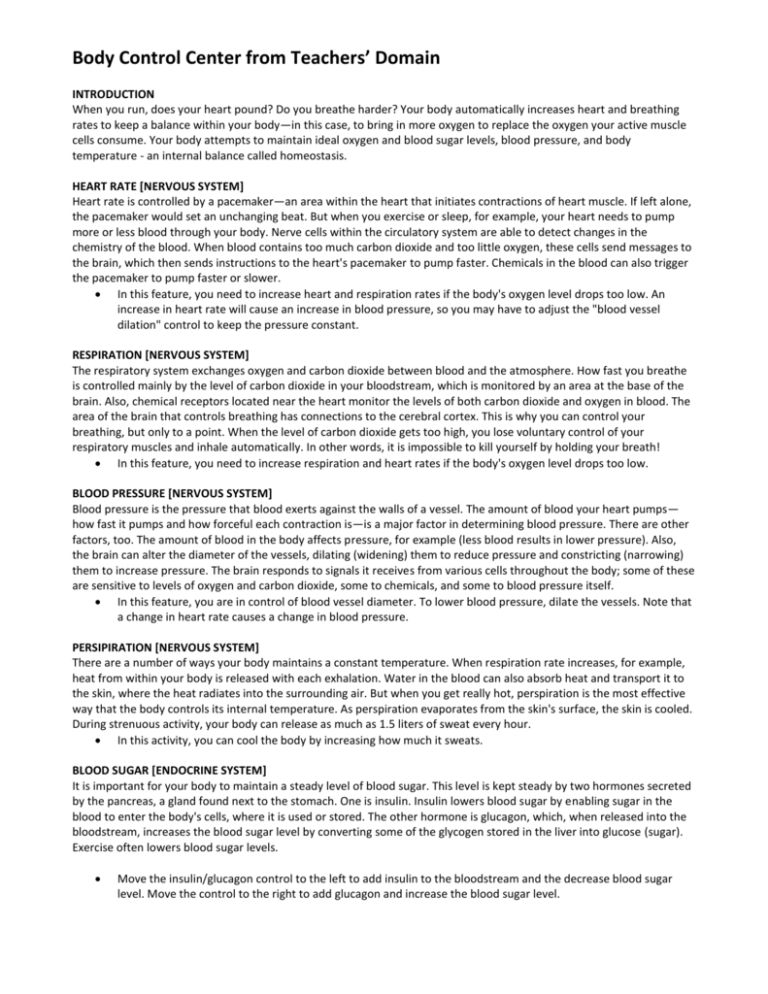
Body Control Center from Teachers’ Domain INTRODUCTION When you run, does your heart pound? Do you breathe harder? Your body automatically increases heart and breathing rates to keep a balance within your body—in this case, to bring in more oxygen to replace the oxygen your active muscle cells consume. Your body attempts to maintain ideal oxygen and blood sugar levels, blood pressure, and body temperature - an internal balance called homeostasis. HEART RATE [NERVOUS SYSTEM] Heart rate is controlled by a pacemaker—an area within the heart that initiates contractions of heart muscle. If left alone, the pacemaker would set an unchanging beat. But when you exercise or sleep, for example, your heart needs to pump more or less blood through your body. Nerve cells within the circulatory system are able to detect changes in the chemistry of the blood. When blood contains too much carbon dioxide and too little oxygen, these cells send messages to the brain, which then sends instructions to the heart's pacemaker to pump faster. Chemicals in the blood can also trigger the pacemaker to pump faster or slower. In this feature, you need to increase heart and respiration rates if the body's oxygen level drops too low. An increase in heart rate will cause an increase in blood pressure, so you may have to adjust the "blood vessel dilation" control to keep the pressure constant. RESPIRATION [NERVOUS SYSTEM] The respiratory system exchanges oxygen and carbon dioxide between blood and the atmosphere. How fast you breathe is controlled mainly by the level of carbon dioxide in your bloodstream, which is monitored by an area at the base of the brain. Also, chemical receptors located near the heart monitor the levels of both carbon dioxide and oxygen in blood. The area of the brain that controls breathing has connections to the cerebral cortex. This is why you can control your breathing, but only to a point. When the level of carbon dioxide gets too high, you lose voluntary control of your respiratory muscles and inhale automatically. In other words, it is impossible to kill yourself by holding your breath! In this feature, you need to increase respiration and heart rates if the body's oxygen level drops too low. BLOOD PRESSURE [NERVOUS SYSTEM] Blood pressure is the pressure that blood exerts against the walls of a vessel. The amount of blood your heart pumps— how fast it pumps and how forceful each contraction is—is a major factor in determining blood pressure. There are other factors, too. The amount of blood in the body affects pressure, for example (less blood results in lower pressure). Also, the brain can alter the diameter of the vessels, dilating (widening) them to reduce pressure and constricting (narrowing) them to increase pressure. The brain responds to signals it receives from various cells throughout the body; some of these are sensitive to levels of oxygen and carbon dioxide, some to chemicals, and some to blood pressure itself. In this feature, you are in control of blood vessel diameter. To lower blood pressure, dilate the vessels. Note that a change in heart rate causes a change in blood pressure. PERSIPIRATION [NERVOUS SYSTEM] There are a number of ways your body maintains a constant temperature. When respiration rate increases, for example, heat from within your body is released with each exhalation. Water in the blood can also absorb heat and transport it to the skin, where the heat radiates into the surrounding air. But when you get really hot, perspiration is the most effective way that the body controls its internal temperature. As perspiration evaporates from the skin's surface, the skin is cooled. During strenuous activity, your body can release as much as 1.5 liters of sweat every hour. In this activity, you can cool the body by increasing how much it sweats. BLOOD SUGAR [ENDOCRINE SYSTEM] It is important for your body to maintain a steady level of blood sugar. This level is kept steady by two hormones secreted by the pancreas, a gland found next to the stomach. One is insulin. Insulin lowers blood sugar by enabling sugar in the blood to enter the body's cells, where it is used or stored. The other hormone is glucagon, which, when released into the bloodstream, increases the blood sugar level by converting some of the glycogen stored in the liver into glucose (sugar). Exercise often lowers blood sugar levels. Move the insulin/glucagon control to the left to add insulin to the bloodstream and the decrease blood sugar level. Move the control to the right to add glucagon and increase the blood sugar level. Body Control Center Activity 1. Read a description of each condition. Based on the information, identify which system (nervous or endocrine) regulates each condition. a. heart rate b. respiration c. blood pressure d. body temperature e. blood sugar 2. Understand how the width of blood vessels is related to blood pressure. Think of a garden hose. Without a nozzle, the water pours out. If you put your thumb over the opening making it smaller, the water squirts farter because increasing pressure results in more force. 3. Complete this chart to help you play the game. CONDITION LOW RESPONSE HIGH RESPONSE Blood Delivery heart rate heart rate Oxygen Need respiration respiration dilation dilation perspiration perspiration glucagon insulin Blood Pressure Body Temperature Glucose Level 4. Heart rate, respiration and blood pressure are related. Determine how by manipulating the controls. a. Describe how heart rate and respiration rate respond when oxygen levels decrease b. Describe how a change in heart rate effects respiration rate c. Describe how blood pressure responds to an increase in heart rate. d. Describe how blood pressure is brought back to normal.


